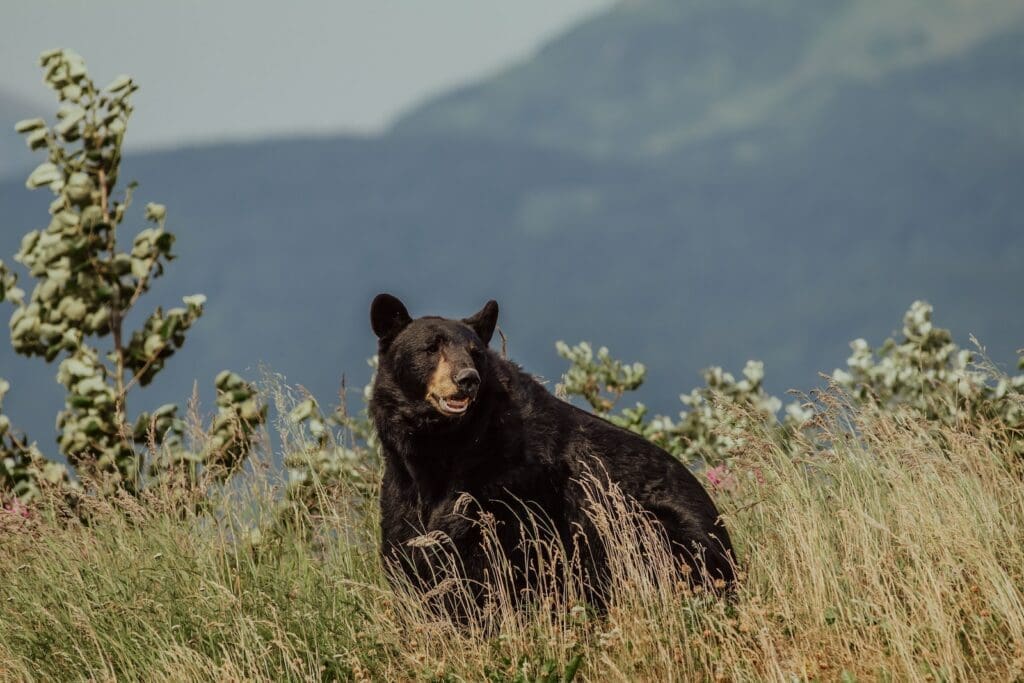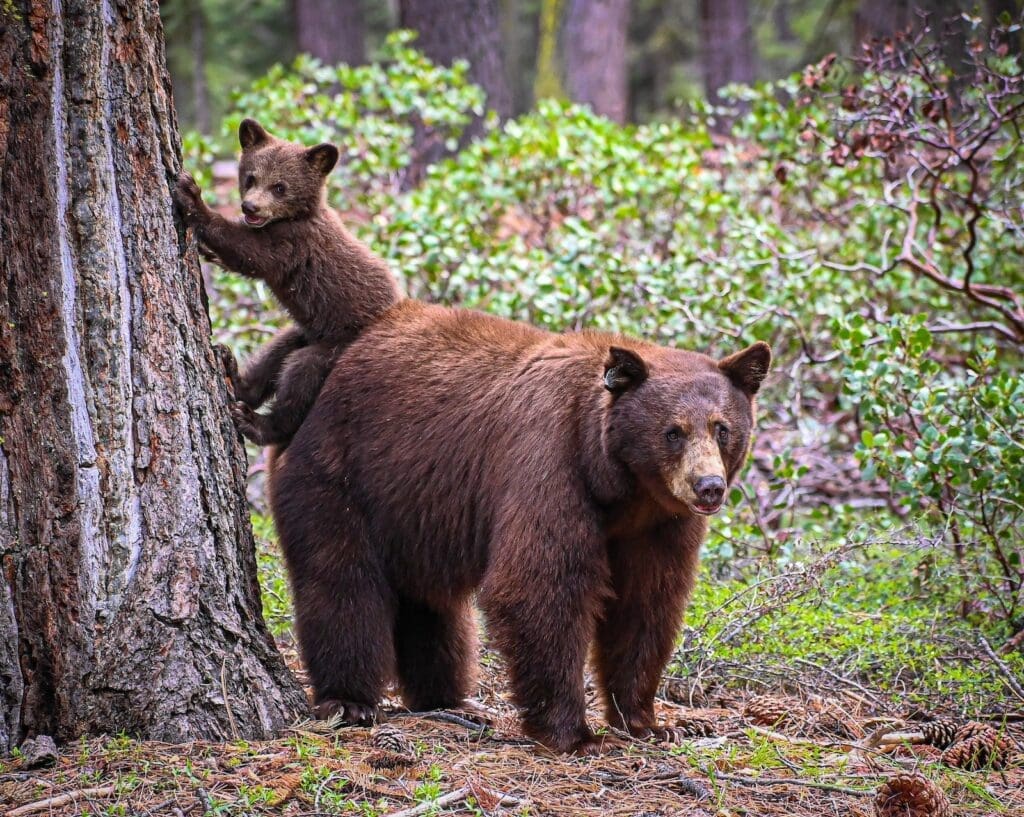
The American black bear is a fascinating creature that is found in Canada, Mexico, and North America. These bears are known for their shaggy fur coats that keep them warm during the cold winter months. While they mostly eat grasses, herbs, and fruit, they are also known to eat fish and other things.
Here are 10 fun facts about the American black bear that you may not have known:
- American black bears are not always black. Some can be a light brown or cinnamon color, and very rarely, completely white.
- Black bears are excellent climbers, and their strong claws are built for climbing. They can run up a tree with incredible speed.
- Black bears are shy and timid creatures. They will usually run away or climb up a tree rather than confront humans.
- Black bears can hibernate for up to 7 months of the year. During this time, they do not eat, drink, urinate, or defecate.
- Black bears have a keen sense of smell and can detect food from over a mile away.
- Black bears can run at speeds of up to 30 miles per hour.
- Black bears are excellent swimmers and are known to swim long distances.
- Black bears have a lifespan of around 20 years in the wild.
- Black bears are important to the ecosystem as they help to spread seeds and control populations of small animals.
- Black bears are not typically aggressive towards humans, but it is important to give them their space and not approach them.
Physical Characteristics
Size and Weight
American black bears are the smallest of the three bear species found in North America. Males can grow up to 6 feet long and weigh between 132 to 661 pounds, while females are slightly smaller, typically weighing between 90 to 300 pounds. The largest males can weigh up to 70% more than females. The head of the black bear is small, but it is supported by a strong neck. The ears are small and rounded.
Color Variations
American black bears have a coat that can vary in color from black, brown, cinnamon, tan, and even blue-gray or blue-black. The color of their coat can vary depending on the region and the season. Interestingly, some black bears can even have a white patch on their chest.
Sense of Smell and Hearing
Black bears have an excellent sense of smell, which they use to locate food sources from miles away. They also have good hearing and can detect sounds at a frequency range that is beyond human capability.
Claws and Teeth
Black bears have sharp claws that are excellent for climbing trees and digging for food. Their teeth are also sharp and strong, which they use to bite into tough food sources like nuts and seeds. Their front paws have five toes with long claws, while their hind paws have four toes with shorter claws. This allows them to climb trees and dig for food with ease.
In summary, American black bears are small compared to other bear species, but they have a strong and sturdy build. Their coat can vary in color depending on the region and season. They have an excellent sense of smell and hearing, which they use to locate food sources. Their sharp claws and teeth make them excellent climbers and diggers.
Habitat and Distribution
North American Range
The American black bear (Ursus americanus) is a widely distributed species, found throughout North America, including Canada, the United States, and Mexico. They are mainly found in forested areas, but they can also be found in mountains, swamps, and other habitats. In the United States, black bears are found in 41 states, while in Canada, they are found in all provinces and territories except for Prince Edward Island.
Habitat in Mexico
In Mexico, the American black bear is mainly found in the northern part of the country, specifically in the states of Chihuahua, Coahuila, Durango, Nuevo León, San Luis Potosi, and Tamaulipas. They inhabit a variety of habitats, including forests, mountains, and deserts. The black bear population in Mexico is estimated to be around 4,000 individuals.
The American black bear has a wide home range, which can vary from 10 to 1,000 square miles, depending on the availability of food and other resources. In Canada, the average home range is around 100 square miles, while in the United States, it is around 20-50 square miles.
In British Columbia, the black bear population is estimated to be around 120,000 individuals, making it one of the largest populations in North America. The habitat in this region is characterized by coastal rainforests and mountainous terrain.
Overall, the American black bear is a highly adaptable species that can survive in a variety of habitats, from densely forested areas to open grasslands. However, habitat loss and fragmentation due to human activities continue to be a major threat to black bear populations throughout their range.

Diet and Hunting
Omnivorous Diet
The American black bear is an omnivore, which means that it eats both plants and animals. The majority of its diet consists of vegetation, such as grasses, herbs, roots, berries, and nuts. In the spring, black bears will eat emerging plants and carrion of animals that died during the winter. During the summer, fruits dominate their diet, and in the fall, they consume both fruit and mast, especially acorns and beechnuts. Black bears have also been known to eat insects, fish, and even deer.
Hunting and Feeding Habits
Black bears are opportunistic feeders and will take advantage of any available food source. They are not typically aggressive hunters, but they will hunt small mammals and fish when they have the chance. Black bears are also known to scavenge for food, especially in areas where human populations are high. They are attracted to garbage cans, bird feeders, and other sources of human food.
When hunting, black bears use their keen sense of smell to locate prey. They are excellent climbers and will often climb trees to search for food. Black bears will also use their strong jaws and sharp claws to dig for roots and other food sources. They have a special adaptation in their digestive system that allows them to digest tough plant materials such as cellulose.
In summary, the American black bear is an omnivorous species that eats a variety of plant and animal materials. They are opportunistic feeders and will take advantage of any available food source. Black bears are not typically aggressive hunters, but they will hunt small mammals and fish when they have the chance. They are attracted to human food sources and will scavenge for food in areas where human populations are high.
Reproduction and Cubs
Breeding Season
American black bears reproduce sexually and reach reproductive maturity at three years of age. The breeding season for black bears typically occurs in late May or June, and it lasts for several weeks. During this time, male black bears roam in search of receptive females. Once a male finds a female, he will stay with her for several days, mating multiple times.
Birth and Care of Cubs
After breeding, female black bears will give birth to their cubs in the safety of their winter dens. Cubs are born in January or February and are very small. They spend the first few months nursing and growing in the den.
Black bear litters can have one to five cubs, but most commonly, litters contain two cubs. The number of cubs in a litter is influenced by the female’s age, nutrition, and the availability of food. Once the cubs are one and a half years old, the female and her cubs will separate, and the female will breed again in the spring.
Black bear cubs are born blind, hairless, and weigh less than a pound. They are entirely dependent on their mother for warmth, protection, and food. Cubs will nurse for several months before starting to eat solid food. Female black bears are very protective of their cubs and will defend them fiercely from any potential threats.
In conclusion, American black bears have a fascinating reproductive cycle. The breeding season occurs in late May or June, and female black bears give birth to their cubs in the safety of their winter dens. Cubs are born blind and helpless and spend several months nursing and growing before emerging from the den with their mother.
Behavior and Lifestyle
Hibernation Patterns
American black bears are known for their hibernation patterns. During winter, they enter a state of reduced activity, which helps them conserve energy and survive the harsh winter months. They usually hibernate in dens, which can be natural cavities or hollow trees. The dens are lined with leaves, grass, and other materials to provide insulation. Black bears typically hibernate for 5-7 months, depending on their location and food availability. During hibernation, their heart rate and breathing slow down, and they do not eat, drink, urinate, or defecate.
Solitary Nature
Black bears are generally solitary animals, except during mating season or when a mother is raising her cubs. They mark their territory with claw marks on trees and by rubbing their bodies against objects. They communicate with each other through body language, vocalizations, and scent marking. They are also known for their keen sense of smell, which helps them locate food and avoid danger.
Climbing and Swimming Skills
Black bears are excellent climbers and can easily ascend trees to escape predators or to reach food. They use their sharp claws to grip the bark and their strong muscles to climb. They are also good swimmers and can swim across rivers and lakes to reach new habitats or to catch fish. They use their powerful front legs to paddle and their back legs to steer. They can swim for long distances without getting tired.
In summary, American black bears have fascinating behavior and lifestyle patterns. They hibernate in dens during winter, are generally solitary animals, and are skilled climbers and swimmers. Their unique adaptations and behaviors make them one of the most interesting animals in North America.

Human Interactions and Threats
Black Bears and Human Encounters
Black bears are generally shy and avoid human interactions. However, they may become aggressive if they feel threatened or if they are defending their cubs. Most black bear attacks on humans are defensive in nature, and can be avoided by taking precautions such as making noise while hiking, carrying bear spray, and properly storing food and garbage.
Human food and garbage can attract black bears, leading to increased human-bear encounters. It is important to properly dispose of food and garbage to prevent habituation and reduce the risk of conflicts between humans and bears.
Conservation Status
The American black bear is listed as a species of least concern by the International Union for Conservation of Nature (IUCN). However, some populations are threatened by habitat loss, hunting, and human-bear conflicts. In some areas, black bears may be killed by humans who perceive them as dangerous predators or a threat to livestock.
Conservation efforts include educating the public about coexisting with black bears, enforcing regulations to reduce human-bear conflicts, and protecting habitat. By taking these measures, humans can help ensure the survival of this iconic North American species.
Subspecies of the American Black Bear
The American black bear is a highly adaptable species, and as such, it has developed several subspecies that are adapted to different environments. There are 16 recognized subspecies of the American black bear, which are distributed across North America.
Some of the most notable subspecies of the American black bear include:
- Ursus americanus americanus: This subspecies is the most widespread, and it is found in most of the United States and Canada. It is also known as the Eastern black bear.
- Ursus americanus cinnamomum: This subspecies is found in the western United States and Canada, and it is characterized by its cinnamon-colored fur.
- Ursus americanus floridanus: This subspecies is found only in Florida, and it is the smallest of all the subspecies.
- Ursus americanus kermodei: This subspecies is found only in a small region of British Columbia, Canada, and it is also known as the “spirit bear” or “Kermode bear”. It is characterized by its white or cream-colored fur.
Each subspecies has unique physical and behavioral characteristics that are adapted to its specific environment. For example, the Florida black bear is adapted to the hot and humid climate of Florida, while the Kermode bear is adapted to the dense forests of British Columbia.
Understanding the different subspecies of the American black bear is important for conservation efforts, as each subspecies may require different management strategies to ensure their survival.



